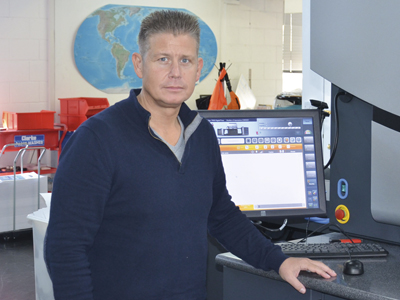Timon Colegrove, CEO of Hunts
What does it take to work in the print industry these days, and how can companies ensure they bring on the next generation with the skills necessary to keep the sector alive? Rebecca Gibbs found out.
How do you establish and maintain an engaged, productive workforce, particularly with the “digitisation” trend now in full flow? According to those who talked to Digital Printer for this article, it’s not just finding the right people for the job – it’s also about highlighting the appeal of a career in print.
Imagine you’re on the phone to a client, or replying to an email, when: “Thwack!” You’ve just had a squidgy ball lobbed at the back of your head. ‘It’s interesting to see how we react to that because it’s quite a testing thing,’ admits Timon Colegrove, CEO of Hunts and instigator of the stressball fights that are a common occurrence at the print, marketing, technology and design company. If this doesn’t sound like a fun way to work then you probably don’t have the “Huntsy” attitude that Timon looks for in a prospective colleague.
Selection process
‘Interviews are very informal,’ says Danny Crane-Brewer, Hunts account director. ‘Basically what happens is the candidates meet Timon; and if he feels they have sufficient Huntsiness he sends them on to me or the other directors, who then get them in to experience the place – come and work shadow. I always stress this to people when I’m interviewing them: it’s two sided’; the candidate is interviewing us as much as we are interviewing them.’ Essentially it’s about looking for a good fit; a mutually beneficial relationship.
Canon looks to hire employees directly through a variety of methods, with its online careers portal being ‘a key tool’ in attracting candidates, says Debbie Brown, Canon UK’s HR director, who reports that ‘It has become increasingly challenging for all types of companies to find candidates with specific niche skill sets, when compared to previous years.’
‘At a certain level, head hunting, retained search, is almost the only way to access the top performers,’ maintains Mike Gilligan, director of printing industry recruiter Mercury Search & Selection. ‘Beyond that, employers who are recruiting need to consider a wide range of benefits together with development opportunities and perhaps even more importantly, passionately present the strength and future prospects of the company and the role to potential new employees. For someone to leave their current role you really need a compelling opportunity that doesn’t seem risky.’
Of course no recruitment method is foolproof, and an element of risk is always involved.
‘The first qualification is trust,’ believes Alan Rigglesford, MD of London printers Kingswood iOptus. ‘And the only way you can get that is by recommendation – from friends and colleagues. Anyone you take on from a previous company, you’ve got to ask why they left that company and what their personal circumstances are – personal gain rather than teamwork and a great work ethic? There are some exceptional people out there, though.’

Alan Riggleford, MD, Kingswood iOptus
Hunts helps with the rehabilitation of ex-offenders, and the company has had some ‘spectacular successes in this area and spectacular failures’, explains Timon, recounting an example of the latter: ‘We had some £5k worth of new phones delivered but nobody ever saw them, then a colleague went missing… Even after that we tried to say “Come back, let us help you get back on track; you can pay back the money over a couple of years.” We never heard from him again. One of a number of tragic failures but we will always do it again.’
Skills shortage?
Stuart Maclaren, managing director of Your Print Partner has experienced different challenges running a business that specialises in large format digital print.
‘The biggest challenge is finding staff for sewing, because we’re a textile printer – I can’t ever find seamstresses,’ he reports. ‘If we went back 20 years or so, there were more seamstresses working in factories where we would be manufacturing clothes in the UK. That doesn’t exist any more.’ To source the skills required without a time machine, YPP has had to look further afield: Eastern Europe – ‘We’ve got three Latvian ladies working for us,’ Mr Maclaren tells DP.
Moving with the times is important in a company which employs both hand skills and automation. ‘You have to update [technology] or your costs don’t work,’ says Mr Maclaren. ‘It would be great to run it a traditional old way but turnarounds and speed of people wanting things now has to change, so systems and everything have to change with it.’
‘The print industry has evolved tremendously in response to customer demands and the advancements in technologies available on the market,’ agrees Debbie Brown. ‘These are among the reasons why Canon invests in comprehensive training for existing employees, to ensure that they have the skills required to continue to be successful in their roles.’
Moving away from the “traditional” of doing things and increasing automation is having an effect on the print workforce, believes Mr Gilligan, who says that ‘reliance on technology [is] leading to a decrease in skill levels as many of the new breed of production operative know the “how to” print and “push a button” but are weak on the “why” and less able to solve technical problems such as colour or substrate issues. As experienced individuals either retire or leave the industry, a wealth of knowledge which could be invaluable to the next generation leaves with them which is not necessarily being replaced.’
This is a concern shared by Aron Priest, CEO of Solopress, who says, ‘I believe there is a [skills] gap in the print industry, because printing companies have concentrated solely on survival or growth, and the training sector has been sadly overlooked, so now we are starting to reflect on this with regret. We can see that apprenticeships will be very much needed in the future, and I think the industry is recognising this now.’
‘”Lack of skills” is typically in the top three concerns in the surveys that we do,’ reveals Charles Jarrold, CEO of the BPIF. ‘There is always an appetite for more skills and more training.’

Charles Jarrold, CEO of the BPIF
‘I do believe there’s a lack of skills out there,’ agrees Alan Rigglesford, ‘but the print industry is constantly evolving and changing to take on new technology. People a generation above me have done typesetting, electro-set and typography, and none of those skills are needed now. I’m a great believer in passing on skills and in terms of training, that’s experienced staff educating employees that are their juniors and getting them up to speed. Common sense is the best qualification that anyone can have.’
Promoting print
Printing is not necessarily seen as an attractive career proposition by the younger generation, and not enough is being done to promote the virtues of print as an occupation within schools and colleges, cautions Mr Gilligan: ‘With a lack of vocational training at a younger age, the vast majority of school leavers are simply unaware of the industry as a platform to build a lasting and highly skilled career.’
Engaging with schools and the local community is a big part of employers attracting new staff, agrees Mr Jarrold. ‘It’s not always clear that the value of apprenticeships is recognisable in schools, and that is an area that we and government need to work on more,’ he states. For example, ensuring that ‘schools are not incentivised or measured in a way that pushes them to direct leavers towards academic and away from vocational’, and providing ‘incentives to achieve the right outcomes for leavers in terms of
opportunity availability.’
As an introduction to print, Canon offers a range of apprenticeship roles in different disciplines across the business. ‘Extensive hands-on training and college learning ensure our apprentices gain recognised qualifications and have the very best support to start their careers,’ says Ms Brown.
Despite changes around the funding regime that took effect this financial year, the BPIF has seen continuing strong demand for apprenticeships over the last twelve months. However, ‘the new apprentice rules mean that 20% of training time has to be “off the job”‘, notes Mr Jarrold.
‘We along with other training entities are asking the government to think this through more carefully for a variety of reasons. Firstly it’s not a quality measure – if someone’s on a contract for more hours (say 40 hrs per week) than someone else (say, 35 hours), the 20% threshold doesn’t make sense. Secondly, it acts as a potential disincentive to put existing workers through apprenticeships if they have to be released from work for a categorical 20% of their time. The underlying principle we understand, but the implementation needs more work.’
An apprentice who is on a scheme that requires them to go to college or training one day a week can actually be problematic if, as Alan Rigglesford notes, ‘that’s when you’re busiest and you don’t want to let them go and it disrupts your production flow.’
Mr Jarrold would also like to see sufficient diversity in provision of training, via independent training providers who are well-placed to understand and meet the needs of the sectors that they are focused on. ‘The assessment and measurement protocols often feel biased towards formal college-based training, which frequently isn’t right either for individuals or for industry,’ he notes.
It’s encouraging to hear that in such a skills-based and driven industry, strong value is put on mentoring and nurturing the next generation – rather than simply “making the grade”.
Read the full August issue of Digital Printer magazine here. Subscribe to the magazine for free – register your details here.





